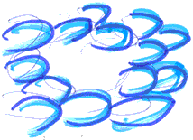Introduction to Cloud Formations
Back to main Cloud Formation Page
Absolutely everything in the universe derives from the same,
identical formation of energetic matter — wave formation —
and adheres to its rules. Consequently, every stable energetic formation
is a wave formation: one quant (picture below, link) composed of two swirls
(vortices) that are connected by an energetic path.
Water molecules, which are also small wave formations, garner their energy from the sun and other sources. Gradually, the molecules become more energetically active and their hydrogen and oxygen electron circles (loop) expand. They, then, act as an anti-gravitation force (for a limited period), which is capable of countering the earth’s gravitation, and they then proceed to evaporate skyward. The aforementioned rise in energy expands the energetic space of the molecules and subsequently the link between neighboring molecules is weakened.
As posited in my equation of gravitation, the waves’ two vortexes are endowed with antagonistic properties, but are nevertheless aligned as one wave formation in which the forces of gravitation and anti-gravitation are in a state of perpetual superposition (Schrodinger’s ingenious idea):
| G | = |
energetic matter |
space |
It is the relative proportion of the energetic loop in a particular formation that determines if the structure is in a wave or particle phase transition. Water molecules that have enlarged their energetic space ascend and enter the wave phase transition. The increase in energy results in larger cloud circles, which facilitate the circulation of additional energetic matter. Energetic matter is in a state of perpetual motion and in order to maintain this movement it must exist in a closed wave formation. Consequently, the energy creates clouds, and every type of cloud is essentially a wave formation.
Logically, waves should constantly expand due to the constant increase of energy from the sun. However, nature follows its own set of rules. Wave theory contends that from the moment that they are formed energetic waves — and in this case hydrogen and oxygen atoms — do not expand. They can only absorb or store limited quantities of energy temporarily. The energy is expelled and dispersed in various ways, primarily by lightning, which is a pure form of energetic matter (quark). Consequently, rain is always accompanied by an increase in the surrounding area’s temperature.
Energetic clouds (waves), which take various forms and sizes,
play an instrumental role in our planet’s circulation and storage
of water and energy.
In the atmosphere, water molecules lose energy due to the low temperature
and they subsequently contract in to a more concentrated form. This obviously
enhances their gravitational properties, and their highly-energetic links
transform into smaller, low-energy connections. Subsequently, the molecules
return to earth and disperse their energy in the form of rain.
There are different types of clouds, but I will concentrate on those that provide the clearest depiction of the interesting phenomenon of wave formation. Cirrus clouds, which are thin and exist at an elevation of 17,100-18,300 feet), constitute a classic example of wave (loops) structure:
A rare formation |
Closed cloud formations illustrate the circulation of energetic matter in circular structures. The inner spaces of a young, highly-energetic cloud appears to be empty, but in fact contain fully energetic matter that blows water molecules to the cloud’s periphery.
The cirrocumulus clouds, which are small and puffy and are to be found at an elevation of between 17,000-18,000 feet) are another prominent example of wave structure (picture, below-left). In these types of clouds, the energetic matter creates chain formations (picture, below-right).
DNA is similarly aligned in chain-like wave patterns (picture,
right). This proves that all energetic matter is governed by the same
rules that guide every energetic ![]() formation,
both organic and inorganic formations. In other words, there is but one
energetic matter that creates everything — vast and minute entities
— by means of its two swirls (vortex). All these structures are
aligned in an identical formation, and are only distinguished by the extent
of their ability to utilize energy from their surroundings to create living
formations, which can take infinite forms. Therefore, there is a lucid
correlation between the behavior of water and its role as the creator
of life.
formation,
both organic and inorganic formations. In other words, there is but one
energetic matter that creates everything — vast and minute entities
— by means of its two swirls (vortex). All these structures are
aligned in an identical formation, and are only distinguished by the extent
of their ability to utilize energy from their surroundings to create living
formations, which can take infinite forms. Therefore, there is a lucid
correlation between the behavior of water and its role as the creator
of life.
Another important phenomenon that proves that clouds are highly-energetic formations are the transparent (apparently empty) space in the middle of clouds (picture, left). This putative void indicates that the formation is imbued with energy that pushes the particles to the sides. It is not merely empty space, as we see small feather like formations have been observed that point inward, towards the direction in which the energy is heading ( picture, right).


As I have mentioned on numerous occasions, energetic matter
created and creates everything and water is but one of its many vital
manifestations. The circulation of water, which is found wherever water
exists, is thus the most significant factor in the formation of life creations.
- end -
Dr. Chaim Tejman, Copyright© 2003. All rights reserved.